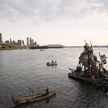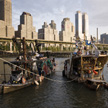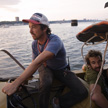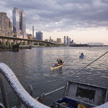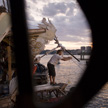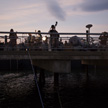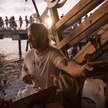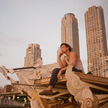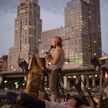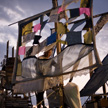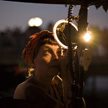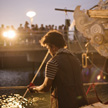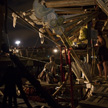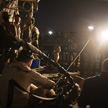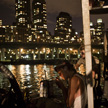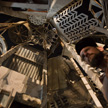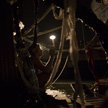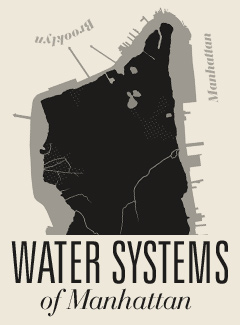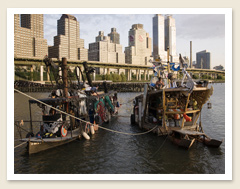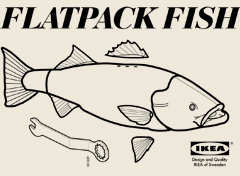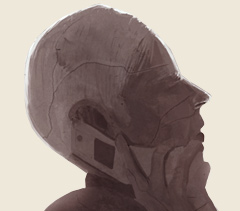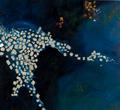Found: Sailor Artists in the River
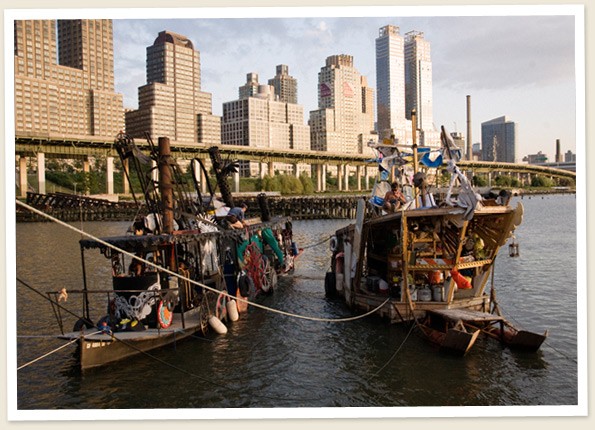
The “Swimming Cities of the Switchback Sea” carried about 50 people down the Hudson River, principally on three rafts and an old steamboat. The crew started in Troy, N.Y., at the end of August and finished in Long Island City in the middle of September. They stopped and gave eleven performances along the way.
“Why take to the water?” one man asked, as part of the performance. “Because soon it will be the only open space left.”
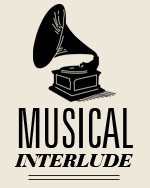
Two songs by Dark Dark Dark, a band which performed on the boats.
A Cloud Story
A Spell For Letting Go
“Why take to the water? Take to it, and you’ll find out.”
His lines were delivered from a podium atop a raft with a large, flat roof. Underneath the roof was the kitchen and what appeared to be a pantry. The raft was adorned with two masts and brightly colored cloth hanging from them.
All of the boats were decorated with art designed by a Brooklyn-based street artist named Swoon. Swoon didn’t travel with them, but she joined them in Queens. When the boats docked at Deitch Studios, they met with a companion exhibit which Swoon also designed. Long ropes, cords and hoses ran from one end of the gallery to the other, and then out the door and onto the dock, linking the boats with one stationary sculpture indoors.
The sculpture, close to the far wall of the gallery, consisted of wooden closets and dressers, along with a yellow desk, open trunks and several ladders spiraling upward toward a kind of mast. At the very top were large pieces of cardboard that showed drawings of two women, supposedly sisters, embracing each other.
According to the press release, the sculpture of the sisters is based on an image Swoon had in a dream. “She envisioned a woman who would gather the boats into a safe haven under her skirts.” I thought that the spiral sculpture also mirrored the assortment of wood pieces on one of the rafts, on which a set of steps led to nowhere, and a group of striped hatboxes sat on top.
I first saw the boats, and their performance, in Nyack. They had docked in Memorial Park, located at the bottom of the hill off Main Street.
I was surprised by what I saw. The performance was set to start at eight and so it was just beginning to get dark when I arrived. The parking lot was crowded with cars and people were walking down the hill carrying food and blankets. A large crowd assembled at the edge of the park along the rocks. The crew had laid down a single plank connecting the smallest raft to the rocks and each of the boats connected to the next with ropes and a narrow wooden plank. The final boat was the black steamboat, whose large red decorative wheel faced the audience.
The crew was larger than I had expected, as was the band, which included a woman playing the accordion with lace in her hair, a man with banjo, and a woman holding a cello. The band was assembled onshore, as was most of the crew, taking time to eat from camping bowls. Then, everyone but the band was called onto the boats and the show began. It started late and so the river was completely dark. The boats looked like imaginative illusions and the show, in which the crew gave short speeches (acting as different characters), danced, and tossed loaves of bread from boat to boat, highlighted the strange wildness that they’d managed to bring to the town. They introduced a “newcomer” who floated along on a gondola with a carved canopy. The show didn’t follow a clear plot and at times the actors weren’t audible. In one memorable moment a dark-haired woman, wearing lipstick-red heels and a polka-dot dress leapt into the water. She reached her arms up and others helped her out quickly.
The little speeches were about leaving the city and coming onto the boats, and also about ghosts. The band, called Dark Dark Dark, played an energetic, sad music, revolving around the accordion and the woman’s strong voice. When the show finished, the crew members came off the boats with hats in hand and asked for donations. I went back to the car, feeling that it was a very dull form of transportation.
Five days later, the Switchback Sea put on a show on the pier in Riverside Park (near 70th Street). Two crew members later told me that one of the highlights of the trip was their “Full-Voltron Party” underneath the George Washington Bridge, where they tied up all the boats together and just let them drift and then danced while they floated. They’d had these parties farther up the river, but the water under the GW was the most exciting spot.
In Riverside Park it wasn’t possible for them to lay down a plank and walk directly onto the boats. The pier where the audience stood was elevated and the boats were docked in front of it. Instead, all the performers had to be carried onto the boats just before the show started.
I spoke to A’yen, the Director of External Relations for the trip, and she let me and Blaine, a photographer, come onto the boats, though she cautioned that we might not be able to get a ride back to the shore before the show started. Blaine and I said that we didn’t mind, as we were curious to see the show from that perspective. A small crowd gathered along the pier and A’yen talked to me about some of the difficulties that they had had, comparing the trip to the first one. In the first, the “Miss Rockaway Armada,” a different set of boats, also designed by Swoon, went down the Mississippi. Fewer people traveled with the boats then: the “Miss Rockaway” group ranged between 12 and 33 people, depending on the night, while 50 to 70 were on the Switchback trip.
“The Mississippi was a much more accessible river,” she said. “The Hudson is much more dense.”
She said that much of the land along the Hudson is private and closed, making it more difficult to find suitable camping grounds near to wherever they’d docked. In the city, most people found places to stay with friends or other members of the group.
She said that she’d also noticed a class difference. She’d noticed more mansions along the Hudson, and less casual interest in the project. Along the Mississippi, she said, people would just show up for their shows, without having heard anything about them beforehand.
“In this river, they might not know you were there if someone hadn’t sent them an e-mail about it,” A’yen said.
She said that they’d met some characters along the way, including Rosie O’Donnell, who saw their boats while she was on hers, and brought them juice boxes and beer. They camped one night at a massive junkyard of boats run by “a salty guy named Randy King.”
“On the Mississippi our goal was ... sustainable access to water but here what we’re doing is Art,” she added. “There’s definitely a sense of whimsy to it.”
Blaine and I climbed onto a small boat with a few others, including A’yen, and we were warned as we were getting on that the corrugated metal of the roof, which had also been designed by Swoon, was razor sharp.
This little boat carried us over to the larger rafts. They too felt precarious, and the piles of art made people walk mostly around the very edges. I walked from one to the next and felt that I was in the way of the crew members, who were beginning to swarm before the show.
“There’s no good place to stand,” one woman said. I found myself steadiest on the steamboat, where I also met the woman who had leapt into the water in Nyack. She wasn’t wearing the red shoes but they were sitting at her feet. She said that her name was Spy — later she gave me her card, which said, Spy Emerson. I asked her if she would jump again and she said no because the water in Nyack had been slimy, and she was worried that the current would be very strong.
I asked her how she got involved and she said, “Chicken John asked us to contribute a boat,” and explained that she was a part of Kinetic Steam Works, a San Francisco group that made and reused old steam engines for various art projects.
People were coming up and down onto the steamboat through the roof.
The show started and proceeded with few changes from what I’d seen in Nyack.
“Do you know what they call us?” one man shouted.
“What do they call us?” shouted a female member of the group.
“They call us high-speed stoners. And do you know what we say? HELL YEAH.”
The whole crew chimed in on “Hell yeah.”
“Do you know what they call us?,” he continued. “Fucked-up ghosts. Do you know what they call us? They call us idiots making mudpies of bullshit! And do you know what we say?
“HELL YEAH...”
“Do you know what they call us? They call us a pack of specters. They call us rag-tag. You know what we say?”
“HELL YEAH.”
“Do you know what they calls us? Very tempting. Do you know what they call us? They call us a fun idea. They also call us the beginning of the end. And you know what we say?”
“HELL YEAH.”
Another girl did go into the water but emerged unscathed.
The lights were bright against the boats, which made it difficult to see much of the audience’s reaction, but it seemed that a sizable and attentive crowd had gathered.
After the show, Chicken, whose name is also listed on the Switchback website as John Rinaldi, led me around the other three boats and showed me their different engines. All three were car engines but he ran them on vegetable oil, wood and coffee grinds. They were decorated too with a tire and a car wheel. He said that he’d used about 150 pounds of wood as fuel over the course of the trip, which he had stored in the hold of one of the boats. Both the art and the engines were designed to reuse and recycle materials.
But Chicken said that the art was a pain and held out his arm which was wrapped in gauze. He said he’d hurt himself and his arm still hurt so much that he thought something was lodged in it.
He and another man carried us back to the park in a little boat. We landed right on the rocks, looking up at the wall of Trump buildings.
I caught up with them again after they’d docked in Queens. They arrived dramatically at the gallery, wearing their party clothes and drawing up the boats almost exactly at seven o’clock. A woman in a black dress, with a yellow scarf tied around her neck, waved at the crowd assembled in the front of the gallery.
Apparently it hadn’t been easy to make the trip around the southern tip of Manhattan. A brief appeared in the New York Times: “Art Ships Are Stopped.” The crew said that they had been pulled over by police once they’d gotten past the Brooklyn Bridge, and given a ticket for not having the proper fire extinguisher on the boats. The article added that they had been spotted by travelers on the Staten Island Ferry, who didn’t think that the boats looked “seaworthy.”
Then, after they landed in Queens they encountered the police again. Spy said that she was alarmed to find herself, about thirty hours after they’d docked, looking down the barrel of a policeman’s gun.
“You guys look like a bunch of fucking pirates,” the NYPD officer shouted, according to Spy. “Where I come from, this is kind of odd.”
Spy said that they police had come because they had unwittingly docked in front of an armored car facility that transports federal money, and someone inside had gotten nervous.
A’yen also said that in terms of costs, permits and red tape, New York had been a difficult place to navigate.
“Growing up in New York I knew that there were a lot of rules, but in a post-9/11 time it seems even more regulated than I thought it would be,” she said.
“The overwhelming amount of traffic and worries about terrorism have made looking different on the water a very suspect thing to do,” she wrote later. “Someone on the Staten Island Ferry was actually panicked enough at seeing us that they assumed we were pirate terrorists and called for help.”
But New York and its density did have certain advantages: they were able to appreciate, from a singular perspective, structures that support millions of people. The boats had a different effect when juxtaposed with the New York City skyline than they had along the peaceful riverbank in Nyack., where only the dark outlines of trees had been visible on the opposite shore. I saw the show again on 9/11 when the two columns of light shot up behind them; the audience faced the river and the Queensboro Bridge.
A few of the crew members said that traveling under the bridges had been the most exciting part.
Chicken said that he used to drive a truck around New York, but that traveling on a boat “completely changed my relationship to the city.”
“It felt like: If we can do this, what can’t we do.”
Ashira Siegel lived in Brooklyn for eight years and ran a bicycle delivery and messenger service. She said that she’d biked over the bridges all the time but going under them on the boat gave her a new sense of scale.
“They are such fantastic structures. You feel super tiny going under them,” she said. “To see New York City from the water, from boats that my friends built was super-empowering and beautiful.”
Spy said that she stood on the roof of the steamboat as it went under the Brooklyn Bridge.
“My favorite part was seeing the support wires of the bridge cross hatch and become like wings. It was so emotional to see the city from that angle,” Spy said. “Like strings of harp into wings.”

